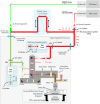This is a preprint.
CRASH2p: Closed-loop Two Photon Imaging in a Freely Moving Animal
- PMID: 38826435
- PMCID: PMC11142166
- DOI: 10.1101/2024.05.22.595209
CRASH2p: Closed-loop Two Photon Imaging in a Freely Moving Animal
Update in
-
Closed-loop two-photon functional imaging in a freely moving animal.Nat Commun. 2025 Jul 1;16(1):5950. doi: 10.1038/s41467-025-60648-x. Nat Commun. 2025. PMID: 40593537 Free PMC article.
Abstract
Direct measurement of neural activity in freely moving animals is essential for understanding how the brain controls and represents behaviors. Genetically encoded calcium indicators report neural activity as changes in fluorescence intensity, but brain motion confounds quantitative measurement of fluorescence. Translation, rotation, and deformation of the brain and the movements of intervening scattering or auto-fluorescent tissue all alter the amount of fluorescent light captured by a microscope. Compared to single-photon approaches, two photon microscopy is less sensitive to scattering and off-target fluorescence, but more sensitive to motion, and two photon imaging has always required anchoring the microscope to the brain. We developed a closed-loop resonant axial-scanning high-speed two photon (CRASH2p) microscope for real-time 3D motion correction in unrestrained animals, without implantation of reference markers. We complemented CRASH2p with a novel scanning strategy and a multi-stage registration pipeline. We performed volumetric ratiometrically corrected functional imaging in the CNS of freely moving Drosophila larvae and discovered previously unknown neural correlates of behavior.
Conflict of interest statement
Declaration of Interests The authors declare no competing interests.
Figures







Similar articles
-
Closed-loop two-photon functional imaging in a freely moving animal.Nat Commun. 2025 Jul 1;16(1):5950. doi: 10.1038/s41467-025-60648-x. Nat Commun. 2025. PMID: 40593537 Free PMC article.
-
Wide-field fluorescence navigation system for efficient miniature multiphoton imaging in freely behaving animals.Neurophotonics. 2025 Apr;12(2):025018. doi: 10.1117/1.NPh.12.2.025018. Epub 2025 Jun 27. Neurophotonics. 2025. PMID: 40584176 Free PMC article.
-
Interventions for promoting habitual exercise in people living with and beyond cancer.Cochrane Database Syst Rev. 2018 Sep 19;9(9):CD010192. doi: 10.1002/14651858.CD010192.pub3. Cochrane Database Syst Rev. 2018. PMID: 30229557 Free PMC article.
-
Signs and symptoms to determine if a patient presenting in primary care or hospital outpatient settings has COVID-19.Cochrane Database Syst Rev. 2022 May 20;5(5):CD013665. doi: 10.1002/14651858.CD013665.pub3. Cochrane Database Syst Rev. 2022. PMID: 35593186 Free PMC article.
-
Novel application of metabolic imaging of early embryos using a light-sheet on-a-chip device: a proof-of-concept study.Hum Reprod. 2025 Jan 1;40(1):41-55. doi: 10.1093/humrep/deae249. Hum Reprod. 2025. PMID: 39521726 Free PMC article.
References
Publication types
Grants and funding
LinkOut - more resources
Full Text Sources
